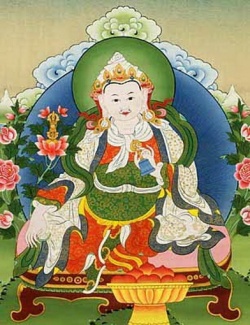Difference between revisions of "Suchandra"
| Line 1: | Line 1: | ||
[[File:Sucandra-77287.jpg|thumb|250px|]] | [[File:Sucandra-77287.jpg|thumb|250px|]] | ||
| − | [[Suchandra]] (Tib. [[Dawa Sangpo]]) c. 900 to 876 BC. The[[ first Dharma king of Sambhala]], [[Sucandra]] ([[zla ba bzang po]]), an [[emanation | + | [[Suchandra]] (Tib. [[Dawa Sangpo]]) c. 900 to 876 BC. The [[first Dharma king of Sambhala]], [[Sucandra]] ([[zla ba bzang po]]), an [[emanation of Vajrapāṇi]], who is said to have received the [[Kālacakra teachings]] from the [[Buddha]]. According to [[Indian]] and [[Tibetan]] legend, [[King Suchandra]] (Tib. [[Dawa Sangpo]]) of the northeastern [[Indian]] [[Kingdom of Shambhala]] was the one who requested [[teaching]] from the [[Buddha]] that would allow him to practice the [[dharma]] without renouncing his [[worldly]] enjoyments and responsibilities. In response to his request, the [[Buddha]] gave the first [[Kalachakra tantra initiation]] and teachings at [[Amaravati]], a small town in [[Andhra Pradesh]] in southeastern [[India]], supposedly [[emanating]] at the same [[time]] he was also delivering the [[Prajna Paramita sutras]] at [[Vulture Peak]] Mountain at [[Rajgir]] in [[North]] [[India]]. Along with [[King]] [[Suchandra]], 96 minor [[kings]] and emissaries from [[Shambhala]] are also said to have received the teachings. |
| − | [[Suchandra]] is considered to be an [[emanation | + | [[Suchandra]] is considered to be an [[emanation of Vajrapani]], and a [[bodhisattva]] on the 10th ground. By practicing the [[Kalachakra]], the whole of [[Shambhala]] became an [[enlightened]] {{Wiki|society}}, with [[Suchandra]] as the [[ruler]]. [[King]] [[Suchandra]] wrote down the [[Kalachakra]] teachings he received, composing the 12,000-verse "[[Mula]]" or [[root text]], which has not survived. He also built a huge three-dimensional [[Kalachakra mandala]] in the center of the {{Wiki|kingdom}}. [[Suchandra]] is said to have [[died]] only two years after receiving the teachings. The six [[kings]] who followed him were known as "[[dharmarajas]]" or "[[truth kings]]," and each is said to have reigned for over 100 years. The twenty-five rulers that follow them are known as [[Kalki kings]]. |
{{W}} | {{W}} | ||
[[Category:Kings of Shambhala]] | [[Category:Kings of Shambhala]] | ||
Revision as of 04:31, 14 December 2014
Suchandra (Tib. Dawa Sangpo) c. 900 to 876 BC. The first Dharma king of Sambhala, Sucandra (zla ba bzang po), an emanation of Vajrapāṇi, who is said to have received the Kālacakra teachings from the Buddha. According to Indian and Tibetan legend, King Suchandra (Tib. Dawa Sangpo) of the northeastern Indian Kingdom of Shambhala was the one who requested teaching from the Buddha that would allow him to practice the dharma without renouncing his worldly enjoyments and responsibilities. In response to his request, the Buddha gave the first Kalachakra tantra initiation and teachings at Amaravati, a small town in Andhra Pradesh in southeastern India, supposedly emanating at the same time he was also delivering the Prajna Paramita sutras at Vulture Peak Mountain at Rajgir in North India. Along with King Suchandra, 96 minor kings and emissaries from Shambhala are also said to have received the teachings.
Suchandra is considered to be an emanation of Vajrapani, and a bodhisattva on the 10th ground. By practicing the Kalachakra, the whole of Shambhala became an enlightened society, with Suchandra as the ruler. King Suchandra wrote down the Kalachakra teachings he received, composing the 12,000-verse "Mula" or root text, which has not survived. He also built a huge three-dimensional Kalachakra mandala in the center of the kingdom. Suchandra is said to have died only two years after receiving the teachings. The six kings who followed him were known as "dharmarajas" or "truth kings," and each is said to have reigned for over 100 years. The twenty-five rulers that follow them are known as Kalki kings.
